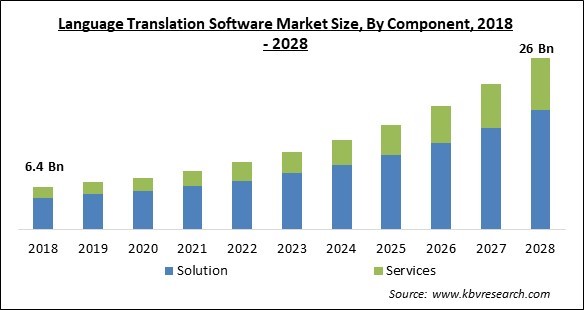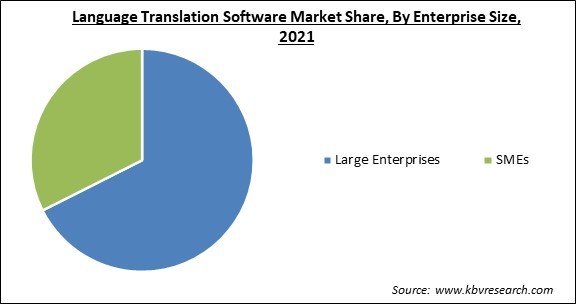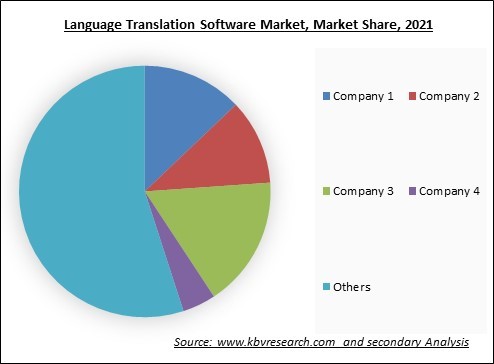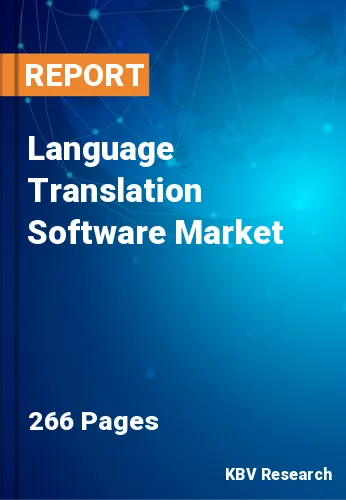The Global Language Translation Software Market size is expected to reach $26 billion by 2028, rising at a market growth of 17.0% CAGR during the forecast period.
Language translator software creates a setting that is consistent and risk-free that assists in the work of a translator, making it easier and more efficient. In addition, software designed specifically for translation offers a variety of tools, features, and resources that can be utilized to facilitate an overall streamlining of the process of translation and the rapid production of high-quality translations.

The ideal translation software will allow businesses to centralize not only the translation process but also data analysis, content distribution, reporting, and project management as well. In addition, brands may employ translation and localization technologies to empower translators by moving away from the time-consuming practice of translating blindly using a spreadsheet and towards an entirely automated and transparent process.
The expansion of the language translation software market is being driven by a rise in the adoption of smartphones around the world as well as an increase in the investments made by governments. In addition, growing company communication needs are projected to give several prospects for advancing language translation software. These alliances lead to the development, indigenous design, manufacturing, and implementation of cost-effective solutions and products.
In addition, government agencies use language translation software for various objectives, including providing immigration services, engaging in diplomatic relations, and doing international business. In addition, indigenous intellectual property (IP) will be bolstered owing to this endeavor, and it will open up new doors for the wider adoption of language translation products and solutions. In addition, the operations that the government engages in regarding the language translation software business have the overarching objective of encouraging the development of the technology, promoting its implementation, and improving the quality of services that are provided to locals.
While the pandemic had a moderate impact on the work-from-home conditions, it had a negative impact on end users' business operations, particularly in the IT and automobile industries. Governments in the region were forced to enact emergency laws due to the rise in COVID-19 cases, which caused the closure of core businesses in the manufacturing, IT, transportation, and corporate sectors, as well as universities and schools. This led to lower adoption of translation software. However, as most IT staff members worked from home during the current outbreak, cloud-based software suppliers benefited greatly. In order to use such solutions, businesses now need to collaborate with machine translation software companies. In light of all these factors, the pandemic initially impacted the market negatively, but the market recovered steadily after the initial months.
For the information on the government-run website is to be accessible to all citizens, it must be offered in "local languages." The government's initiatives are anticipated to increase public awareness in many nations. The localization of websites can assist governments in achieving this objective. Therefore, most government institutions are investing in LTS to improve communication with residents. As more governments worldwide adopt language translation software, it will further promote the growth of the market in the coming years.
Due to the increased use of mobile devices, businesses, and consumers highly value the mobile-first approach. As a result, many companies worldwide are creating solutions for mobile users. As a result, the demand for mobile-based language translation software is rising among individual students and business groups. This is driving the demand for language translation. The advanced technology needed to develop language translation software has yet to fully infiltrate the industry for smartphones as well as other smart devices. As a result, the use of language translation software has increased dramatically.

Open-source suppliers offer reporting, analysis, translation, and data warehouse creation tools. Since the majority of small businesses in developing nations like China and India cannot afford to invest in pricey web-based or cloud-based language translation software, open-source translation software is growing in popularity. Thus, it is anticipated that the growing variety of open-source language translation software suppliers will restrain the growth of the language translation software market throughout the forecast period.
Based on component, the language translation software market is categorized into solution and services. The solution segment garnered the highest revenue share in the language translation software market in 2021. The increase in the production of publishable excellent translations for companies to fill the gap in external and internal multilingual communications is responsible for the segment's growth. Other factors that drive the usage of translation solutions include the rising trend of bring-your-own-device (BYOD), the ongoing rise in technological complexity, the increase in digital information and the necessity to secure it, adaptability to meet specific needs, and an ongoing rise in dependence on heterogeneous networks.
Based on enterprise size, the language translation software market is segmented into large enterprises and SMEs. The large enterprises segment witnessed the maximum revenue share in the language translation software market in 2021. Large businesses have historically invested in archaic translation for their content geared toward customers or are considered outbound. However, language translation software can now significantly contribute to developing the relatively new sidebound (customer-to-customer) and inbound (customer-to-enterprise) content types, so they are no longer the only options.

The leading players in the market are competing with diverse innovative offerings to remain competitive in the market. The below illustration shows the percentage of revenue shared by some of the leading companies in the market. The leading players of the market are adopting various strategies in order to cater demand coming from the different industries. The key developmental strategies in the market are Acquisitions, and Partnerships & Collaborations.
On the basis of vertical, the language translation software market is fragmented into IT & telecom, healthcare, manufacturing, BFSI, education, travel & tourism, and others. The BFSI segment acquired a substantial revenue share in the language translation software market in 2021. When planning to share their wealth, sincere investors mostly rely on the company's press releases, yearly reports, and presentations. They, therefore, expect accurate and clear information in their native tongue, so it is important to take into account translating financial documents at a fair price.
| Report Attribute | Details |
|---|---|
| Market size value in 2021 | USD 8.8 Billion |
| Market size forecast in 2028 | USD 26 Billion |
| Base Year | 2021 |
| Historical Period | 2018 to 2020 |
| Forecast Period | 2022 to 2028 |
| Revenue Growth Rate | CAGR of 17% from 2022 to 2028 |
| Number of Pages | 266 |
| Number of Table | 460 |
| Report coverage | Market Trends, Revenue Estimation and Forecast, Segmentation Analysis, Regional and Country Breakdown, Market Share Analysis, Companies Strategic Developments, Company Profiling |
| Segments covered | Component, Enterprise Size, Vertical, Region |
| Country scope | US, Canada, Mexico, Germany, UK, France, Russia, Spain, Italy, China, Japan, India, South Korea, Singapore, Malaysia, Brazil, Argentina, UAE, Saudi Arabia, South Africa, Nigeria |
| Growth Drivers |
|
| Restraints |
|
Based on region, the language translation software market is analyzed across North America, Europe, Asia Pacific, and LAMEA. The North America segment witnessed the largest revenue share in the language translation software market in 2021. High demand for professional translation services, the presence of a sizable industrial sector in the US, legislative measures to foster innovation, and a sizable consumer base are some factors propelling the region's growth. The need for language translation is also growing due to emigration from numerous nations and the presence of large enterprises. The countries in this region that contribute the greatest market revenue are the US and Canada.
Free Valuable Insights: Global Language Translation Software Market size to reach USD 26 Billion by 2028
The market research report covers the analysis of key stake holders of the market. Key companies profiled in the report include IBM Corporation, Google LLC (Alphabet Inc.), Acolad Group, AppTek, LanguageLine Solutions (Teleperformance SE), inRiver AB, Babylon Software Ltd., Lingotek, Inc., and SYSTRAN S.A.
By Component
By Vertical
By Enterprise Size
By Geography
The global Language Translation Software Market size is expected to reach $26 billion by 2028.
An increase in the use of smartphones worldwide are driving the market in coming years, however, Increasing use of open-source translation platforms restraints the growth of the market.
IBM Corporation, Google LLC (Alphabet Inc.), Acolad Group, AppTek, LanguageLine Solutions (Teleperformance SE), inRiver AB, Babylon Software Ltd., Lingotek, Inc., and SYSTRAN S.A.
The IT & Telecom segment acquired maximum revenue share in the Global Language Translation Software Market by Vertical 2021 thereby, achieving a market value of $8.5 billion by 2028.
The North America market dominated the Global Language Translation Software Market by Region 2021, and would continue to be a dominant market till 2028; thereby, achieving a market value of $9.7 billion by 2028.
Our team of dedicated experts can provide you with attractive expansion opportunities for your business.

